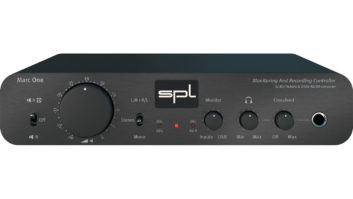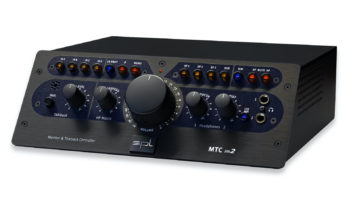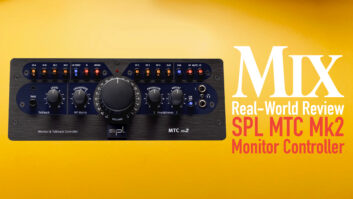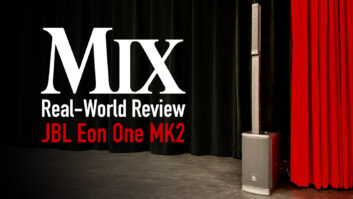
If you always thought SPL products were out of your price range, think again. The vaunted German manufacturer recently released a new range of affordable headphone amps and monitor controllers called Series One. All feature the company’s proprietary Phonitor Matrix, which simulates for headphone users the experience of listening to speakers.
Series One debuted with four products: Phonitor One and Phonitor One d are headphone amps. The Control One is a monitor controller. The Marc One, reviewed here, is described by SPL as a “monitor and recording controller.” It features the Phonitor Matrix, speaker switching, and high-quality D/A and A/D converters. Thanks to the converters, and USB connectivity, you can even use it as a 2-in/2-out audio interface, albeit one that requires external mic preamps.
Heavy Duty
Manufactured in Germany, the Marc One is a tabletop unit that’s a little over eight inches wide and eight inches deep. It appears quite solidly built, with an aluminum faceplate and metal housing.
All controls, except the on/off switch and some dip-switches, are located on the front panel. The I/O, other than the quarter-inch TRS headphone output, is on the rear, as is the input for the external power supply.
The unit provides two sets of quarter-inch speaker outputs: Speaker A features left and right TRS outputs and a TRS subwoofer output; Speaker B consists of left and right TS (unbalanced) outputs. Other I/O includes two stereo pairs of quarter-inch line inputs, again, one pair balanced and one unbalanced (for keyboards, tape decks, etc.), and one set of quarter-inch unbalanced line outputs.
I would have preferred that all the connections were balanced, particularly for Speaker B. When queried about it, SPL pointed out that it had to economize in some ways to keep the price as low as it did. And overall, they succeeded in keeping the sound quality remarkably high.
Switch and Dip
On the front panel, Marc One sports a three-position toggle for speaker switching. Up selects Speaker pair A and down Speaker pair B. The middle position functions as a mute, turning off signal to both sets of speakers but not the headphone output.
Another three-way switch lets you choose one of three monitoring modes: Stereo, Mono or L/R > R/L. The latter, something you don’t see on many monitor controllers, reverses the stereo image. According to SPL, it will streamline the workflow if you’re in a sound-for-picture situation and are searching for sound effects that move across the stereo image. That way, you can preview the samples in the correct direction to match the picture. I also found it handy when mixing as a way to briefly alter my perspective, which is always helpful.
Two rear-panel dip switches provide additional ways to change Marc One’s functionality. Switch 1 cuts the monitor output by 10 dB to give more of a usable range with the Volume control if your powered monitors are unusually loud. Switch 2 mixes the outputs of channels 1 and 2 going into your computer through USB. So, for example, you could plug in two sources (either line in, or from a mic preamp unit or audio interface) and record them both into a single mono channel on your DAW.
Click and Turn
In addition to the speaker switcher, the front panel sports a large knob that controls Speaker A and B output levels. A smaller knob called Monitor lets you vary the balance between what’s coming into the inputs—the direct sound—and what’s coming back from the DAW. Such a control is common for providing no-latency monitoring on audio interfaces that don’t use software-based mixers.
Next is a headphone volume control. It’s handy to have a different knob for the headphone level than for the monitor level. The headphone amp is a class AB push-pull design that SPL says gives you more gain and output voltage than a class A amp would. My experience with it backs this up. It’s loud, and it’s clean.
The Marc One doesn’t have talkback or Dim functions, features you’ll find on many monitor controllers. Those are mainly useful when doing sessions with multiple musicians, whereas Marc One seems destined for small studios where only one or two sources at a time get recorded. Given that, it makes sense why SPL didn’t include them.
Fun With Phonitor
The last knob on the right, labeled Crossfeed, is for the Phonitor Matrix. On higher-end units such as the Phonitor 2, SPL offers three adjustable parameters for the Phonitor function: Crossfeed, Speaker Angle and Center Level. On the Marc One, you only get Crossfeed. However, the Speaker Angle and Center Level parameters are preset at 30 degrees, and -1 dB, respectively, which SPL says are the most commonly used values.
The Crossfeed knob controls the interaural level difference; that is, how much of the left ear you hear in the right, and vice versa. When it’s turned completely down, your headphones sound normal, with complete separation between left and right. As you turn up the Crossfeed, you start getting more sound from the opposite side blending in.
The effect is more like what you hear from speakers, where the separation is not as complete because of the sound waves bouncing around in the room. I found I was most comfortable with the image I got with the Crossfeed knob set to about 2 o’clock, which is a little more than halfway up.
Having the Phonitor feature allowed me to mix on headphones with a lot more confidence. As a result, I was able to work on projects late at night or early in the morning without worrying that the sound from my (not-completely soundproof) studio would bother anyone.
You can get software plug-ins that provide a similar speaker simulation experience. The big drawback of those is that you have to put them on the master bus. As a result, you need to remember to bypass the plug-in whenever you bounce a mix because its processing is only for playback. But the Phonitor Matrix only affects what’s going out the headphone output, so you can leave it on all the time if you want.

The Red Light Is On
The feature that sets the Marc One apart from the Control One is its A/D and D/A conversion and USB connectivity (class compliant for Mac and iOS, a driver required for Windows). Although you can record through it into your DAW, the Marc One isn’t an audio interface in the ordinary sense because it has no mic preamps. However, if you have an external mic pre unit or an interface with mic pre’s and line outputs, you can connect those to Marc One’s line inputs.
The metering is minimal, consisting of input overload lights for each of the two channels, but considering you’d probably have meters on your mic preamp, that’s not a significant issue.
Why would you use Marc One as your interface if you already have one? A good reason is its conversion. SPL equipped it with 32-bit AK4490 DAC chips that can handle sampling frequencies up to 768 kHz PCM and support Direct Stream Digital playback. The audio quality is pristine and impressive. I compared its conversion with that of another interface that I really like, and the sound quality of the Marc One was even better.
The limitation to recording through the unit is that you only get two channels in and out. But if that’s not a dealbreaker, and if you have other mic preamps, you might consider it as a recording front end.
The Deal
Testing out Marc One for this review was a positive experience from start to finish. It was easy to set up and simple to use. It was a snap to integrate it into my workflow, both for tracking and mixing.
At times, I used it strictly as a monitor controller and headphone amp, and at other times as my audio interface. It has impressive sound quality and a well-thought-out feature set—including the incredibly useful Phonitor Matrix.
But perhaps its most significant attribute is its value. To get an SPL hardware unit with this type of sound, you’d expect to have to spend quite a bit more. It represents an impressive breakthrough from a price/performance standpoint.
The only thing I wonder about is how it will fit into the market. From a studio standpoint, it’s kind of a “tweener,” or maybe “hybrid” is a better word. It’s not quite an audio interface because of its lack of preamps and low channel count, but it’s more than just a monitor controller.
If you’re looking strictly for a monitor controller, you might be better off with the Control One, which has the same functionality minus the converters and USB connectivity. But if you’re also intrigued by the idea of being able to run your audio through an SPL unit with high-quality converters—both on the way in and the way out—you’ll want to check out Marc One.
PRODUCT SUMMARY
COMPANY: SPL
PRODUCT: Marc One
WEBSITE: www.spl.audio/en
PRICE: $719
PROS: Excellent sound quality. SPL quality at an affordable price. Phonitor Matrix provides speaker simulation over headphones. Powerful and clean headphone amp. 32-bit/768kHz AK4490 converters. Speaker switching. Subwoofer output for speaker A. Solid build quality.
CONS: Speaker B outputs are unbalanced. Recording capability only 2-in and 2-out. No Talkback or Dim features.







